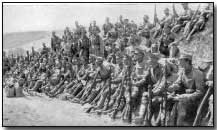Feature Articles - The Minor Powers During World War One - Austria-Hungary
 Austria-Hungary was the power whose territorial ambitions played a large
part in the coming of war in 1914. Although head of an increasingly
fossilised and outdated regime, the Habsburg emperor
Franz Josef was an
expansionist.
Austria-Hungary was the power whose territorial ambitions played a large
part in the coming of war in 1914. Although head of an increasingly
fossilised and outdated regime, the Habsburg emperor
Franz Josef was an
expansionist.
In 1914, his latest addition to the Austro-Hungarian Empire was Bosnia-Herzegovina. Bosnian Serbs resented Austrian rule and sought the protection of independent Serbia. It was one of these Bosnian Serb groups, the Black Hand, that assassinated the Crown Prince, Franz Ferdinand in Sarajevo.
Austria, egged on by her German allies, quickly sent Serbia an ultimatum and declared war on the 28th July 1914. A few days later, on August 1st, Germany declared war on Russia - seen as the champion of the Slav cause by Serbs, Russians and Germans alike. Austria declared War on Russia a few days later, followed by a declaration of war on Belgium on 7th August.
By the end of the year, her association with Germany would see her at war with France, Britain and Japan, while her attack on Serbia also drew in Montenegro.
The Austro-Hungarian empire encompassed many peoples, and so did its army. Poles, Czechs, Slovaks, Croats, Slovenes, Bosnians, Italians, Ruthenes and Jews fought in the army alongside the Austrians and Hungarians, and under Austrian and Hungarian officers.
Appealing to nationalistic aspirations, the Austrians formed the Polish Legion, led by Pilsudski. The Poles were encouraged to think of this as the precursor to a Polish national army. (The Russians were trying similar tactics in their part of Poland.)
After initial setbacks in Galicia (against the Russians) and Serbia, the Austrian army had more success in 1915, and by the middle of 1916 had conquered Serbia and Montenegro, pushed the Russians back from Poland and by the end of the year Romania had fallen to a combined German-Austrian-Bulgarian assault.
Similarly, the Italian attacks on the South Tirol and the Isonzo river had been repeatedly repulsed.
 The Czech
Legion, captured by the Russians, were freed after the Russian surrender at
the treaty of
Brest-Litovsk.
The Czech
Legion, captured by the Russians, were freed after the Russian surrender at
the treaty of
Brest-Litovsk.
All 60,000 of them made their way from Siberia to the Russian Far East, where they declared themselves for the Allies and began to make their way back to Europe to fight alongside the allies.
But to do that, they would first have to fight their way through the Bolsheviks. This they proceeded to do throughout the period of the allies' ill-fated expedition in support of the Tsarist forces in Russia.
Finally, with British and French reinforcements reaching the Balkans and Italy, the Austrian Emperor decided in October 1918 to sue for peace. On October 29th, as the Austrian army retreated from the Piave, British and Italian aircraft wreaked havoc on the fleeing columns.
Several thousand bombs were dropped and over 50,000 rounds fired by the RAF alone. The Austrian armistice took effect on November 4th.
In all, 1,495,200 Austro-Hungarian soldiers died during the Great War, including 480,000 that died as prisoners of war. (Source: Holger Herwig - The First World War: Germany and Austria-Hungary 1914-1918).
The first zeppelin raid on London was on 31 May 1915. Earlier raids in January 1915 had avoided London. The London raid resulted in 28 deaths and 60 injuries.
- Did you know?
